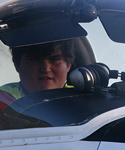
.jpg)
.jpg)
.jpg)

Thanks for looking 8-)





Not sure how you worked out the camera issues, but I think it's a good first attempt.
Can we see one without the editing? ;D
No idea about the "EV" question... is that a setting on the camera? If so, I suggest you consult the manual.
I have a couple of suggestions, though:
Get a UV filter for your camera, or a Moon filter (basically a blue filter) for your telescope. It cuts the glare somewhat, which helps with that "blooming" effect.
Also: filter or no, avoid photographing the Moon when it is past half-phase. A barely-there sliver of a crescent yields better results, because there's less total light coming at you, and the long shadows really show off the terrain features.
 , I don't know what EV stands for up it has a bunch of numbers like +2, +1, 0, -1, -2,... :-? I would look in the manual but the camera 7 years old and the manual lost, but it is a whole 1.2 mp camera (Impressive, I know 8-)) , I thing that might be what caused the blooming effect, but I'm not sure
, I don't know what EV stands for up it has a bunch of numbers like +2, +1, 0, -1, -2,... :-? I would look in the manual but the camera 7 years old and the manual lost, but it is a whole 1.2 mp camera (Impressive, I know 8-)) , I thing that might be what caused the blooming effect, but I'm not sure  As for ones without the editing they look like a fuzzy circle, because the camera focuses on the eyepiece not what through it
As for ones without the editing they look like a fuzzy circle, because the camera focuses on the eyepiece not what through it 

I don't know what EV stands for up it has a bunch of numbers like +2, +1, 0, -1, -2,... :-? I would look in the manual but the camera 7 years old and the manual lost, but it is a whole 1.2 mp camera (Impressive, I know 8-)) , I thing that might be what caused the blooming effect, but I'm not sure


I don't know what EV stands for up it has a bunch of numbers like +2, +1, 0, -1, -2,... :-? I would look in the manual but the camera 7 years old and the manual lost, but it is a whole 1.2 mp camera (Impressive, I know 8-)) , I thing that might be what caused the blooming effect, but I'm not sure
I suspect that EV = Exposure Value. You might find this useful. http://www.chem.helsinki.fi/~toomas/photo/ev.html



Users browsing this forum: No registered users and 195 guests